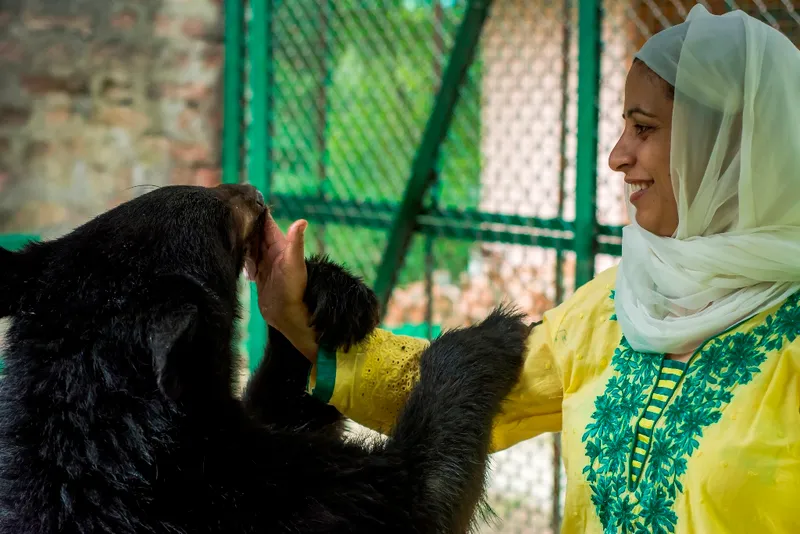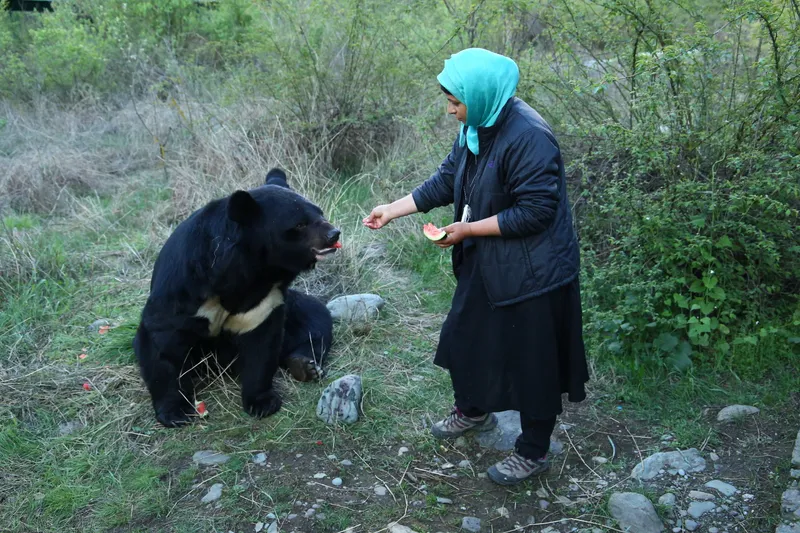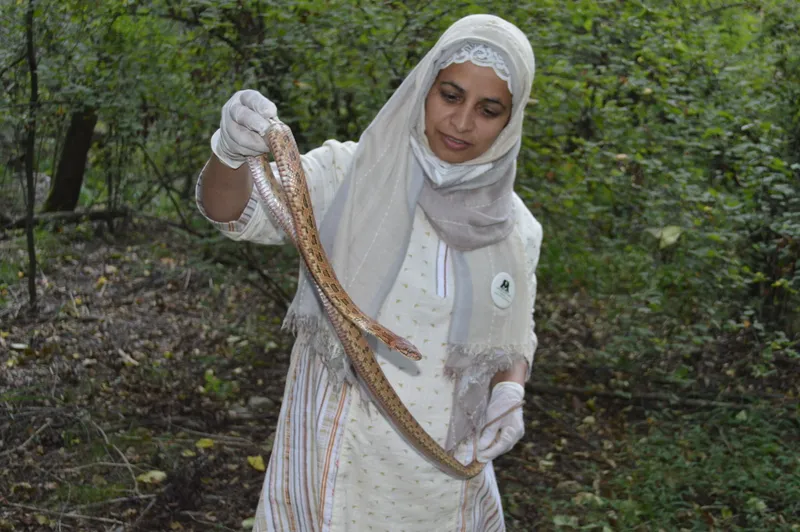Aaliya Mir on a mission to rescue wild animals and mitigate human-animal conflict in Kashmir Valley
Aaliya Mir is a passionate animal rescuer who spends her time rescuing wild animals in the Kashmir Valley. She is also involved in raising awareness about the need to resolve human-animal conflict in the region.
Three years ago, Aaliya Mir received an emergency call for a rescue operation involving a mother bear and her two cubs. The bears had wandered into human-inhabited zones in the Budgam district of Kashmir. Without hesitation, Mir rushed to the location, where the mother bear and her cubs were seeking refuge in a desolate house.
Word spread quickly, attracting dozens of curious villagers who gathered around the house, eager to witness the rescue effort. Mir and her team assessed the situation and decided that tranquillising the mother bear would be the best course of action. However, upon being tranquillised, the bear fled the house.
Undeterred, Mir shifted her focus to the cubs. She recognised the need to get to them without tranquillising them. However, as her team ventured into the house, one of the cubs leapt out of a window and scrambled up a nearby tree.
Mir and her team immediately dispersed the crowd and devised a plan to coax the cub into a net by shaking the tree it had climbed upon.
After a series of well-coordinated efforts, they successfully rescued both the cubs. However, the mother bear was still out in the open. Determined not to leave her behind, the team came up with a strategy to lure the bear back. They set up a dual cage, anticipating her return during the night. The mother came back for her children and was caught in the cage.
“After rescuing them, we took them to our rehabilitation centre for a few days, after which they were released into safe zones, away from human inhabitation,” Mir explains her adventure to HerStory.
Challenging days like these are par for course for Mir, a passionate wildlife rescuer who spends most of her time rescuing animals such as wild boars, Asiatic Black bears, Himalayan brown bears, leopards, and Levantine vipers in the Kashmir Valley.
Donning a salwar suit and a hijab, she does it all—from climbing ladders to rescue snakes from houses to rescuing dangerous wild boars that stray into human-inhabited zones.

Aaliya Mir
A typical day in her life consists of at least three to four rescue calls. Her work involves navigating her team cautiously to safeguard both the animals and the humans.
Animals that wander out of the forests can be a threat to humans or get attacked by people as they try to safeguard themselves. Hence, the animals need to be rescued and shifted to areas that are safe for them, away from human inhabitation, explains Mir, stressing the need for animal rescue efforts.
Encounters in the wild

Aaliya Mir
For more than a decade, Mir has been a beacon of hope and courage for the animals and the people of Kashmir, as she strives to resolve the human-wildlife conflict in her homeland.
“Some people choose their way, but I believe destiny led mine. I have been an animal lover since I gained consciousness of the world, and life led me on this path which I have embraced with humility and passion,” says this 43-year-old.
Mir is part of the team at Wildlife SOS, a Delhi-based non-profit organisation established in 1995 to rescue and rehabilitate wild animals in distress. She has been the project head and education officer in the Kashmir Valley since 2002. So far, she has been part of more than 400 operations that have rescued leopards, snakes, white and black bears, wild boars, and porcupines from human-inhabited areas.
The rescue process differs from situation to situation. The rescued animal is usually tranquillised. In some cases, trap cages are set up, with baits to catch the animal, while camera traps record the animal’s movements.
After rescue, the animals are taken to rehabilitation centres in Dachigam and Pahalgam, which have been built in accordance with the Central Zoo Authority guidelines.
“Only after a thorough check, if we find that the animal is healthy, do we release them to certain sites which are located away from human-habituated areas. These sites are examined beforehand for the availability of food and animal’s safety.”
Apart from rescue operations, Mir has also been working tirelessly to spread awareness about animal behaviour and teach people how to protect themselves from wild animals.
Nurturing a passion for animals

Mir has been a wildlife enthusiast since childhood. She recalls her father feeding the birds and dogs near their house, a practice she followed as well. As a child, she used to feed and take care of stray animals that wandered near her house and also play with them.
In 2002, while she was pursuing a master’s in mathematics in Delhi, she got married to Dr Shabir Ahmed, a veterinary doctor. From there on, her childhood love for animals turned into a full-fledged passion.
Through her husband’s contacts, Mir got to know about Wildlife SOS and joined the organisation as a volunteer in Delhi. She also started working as a mathematics teacher. But little did she know that life had other plans for her.
While working as a volunteer, Mir realised that protecting animals was her calling. So she decided to quit her teaching job and take up rescue work.
In 2006, a bear entered a village in Kashmir, leaving people in panic. It was chased by a mob armed with sticks and axes. Soon the situation got out of hand, ending in the death of the bear. This incident triggered something in Mir—she realised it was important to take decisive action against human-wildlife conflict in the region and make humans more compassionate towards wildlife.
The team at Wildlife SOS devised a research project to understand the cause of the conflict in the region and find ways to mitigate it. Thereafter, Mir was made the project head and posted in Srinagar.
Striving for human-wildlife co-existence
Mir believes factors such as habitat destruction and changes in land use patterns, due to growing multiple agricultural products such as maize and rice, attract wild animals like bears, contributing significantly to the increasing human-animal conflict.
In their efforts towards preventing this conflict, Mir and her team prioritise education, awareness, and capacity building. Besides rescue operations, the team also educates the local people about wildlife and how to avoid human-wildlife conflicts.
“We organise sessions to foster a deeper understanding of our shared responsibility towards nature,” she says.

Mir and her team also conduct awareness workshops in schools and colleges, teaching students practical ways to safeguard themselves from wild animals, instead of killing or harming them.
“This is the right age for students to learn how one can co-exist with wildlife. In most leopard attacks, small children are found to be the victims, which makes these sessions even more important.”
Challenges along the way
Mir’s journey in a male-dominated field has been quite challenging. She recalls many instances when men questioned her competency as a rescuer.
“In the initial days, whenever there was a rescue call, and I took the lead, people used to whisper behind my back, ‘Yeh karegi rescue?’,” she recounts.
Apart from gender stereotyping, she also had to face resistance from the people of the valley, who were not receptive to the awareness workshops conducted by her.

“At that time, human conflict was a pressing issue in the valley, and neither the government nor the public paid any heed to wildlife. In such a volatile environment, talking about wildlife conservation was extremely difficult.”
However, these situations did not deter her from her path.
Her unwavering dedication to her profession and her sense of responsibility are truly commendable.
When a little girl in a village lost her life after a leopard attacked her, Mir wanted to visit her parents. Although the police refused to let her to visit the girl’s house, she did not listen to them.
“I went to the girl’s place to talk to the parents and share my condolences because that was my responsibility,” she says.
Dedicated to wildlife conservation
Mir has participated in various wildlife research projects such as the Hangul (Kashmir stag) census and the Asian waterbird census. She now plans to conduct brown bear and snake ecology research to better understand the nature of these wild animals.
In March this year, Mir became the first woman from the valley to receive the Wildlife Conservation Award 2023, from the Department of Forest, Ecology and Environment, the Jammu & Kashmir government, in recognition of her efforts towards wildlife conservation.
“I have dedicated my life to these voiceless animals and will continue to work to mitigate human-wildlife conflicts further,” she says.
Edited by Swetha Kannan







